![]()
The Words of the Bouma Family
|
|
The Words of the Bouma Family |
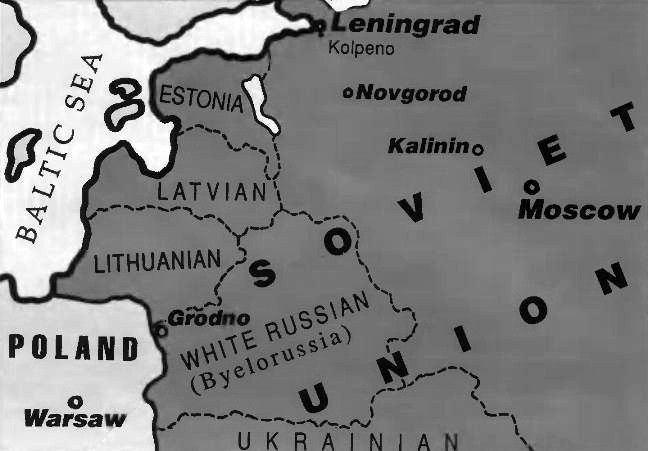
On my third visit to the Soviet Union in April 1990, I was fortunate enough to serve on the staff of the 11th World Media Conference in Moscow and then for the rest of the month stay in Soviet homes and visit friends and contacts. Not only was the Moscow Rally a Cosmic Spring Victory, but my one-woman tour proved how ready and eagerly the Russian people yearn for True Parents in their lives.
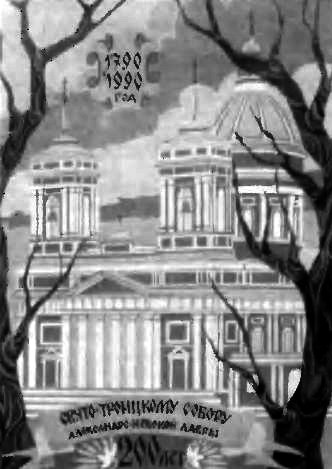
Russian
Easter card depicting Alexander Nevsky Monastery's Holy Trinity
Cathedral.
The challenge of organizing and producing the providential "March on Moscow" for Father to speak the truth of God directly to the Soviet people involved more than we had ever imagined. The 40 staff, technicians and interpreters who not only witnessed the event but, somehow, made it happen, know that as difficult as the event was to manage, we were working with the best the USSR has to offer: a world of influence through Novosti Press Agency and an international trade center and hotel catering to Western dollars and clientele. In addition, the worldwide prayer and spiritual assistance of our movement supporting our efforts were incalculable.
We found that arranging for hundreds of visas and flights into Moscow, as well as juggling accommodations and food for participants in a country with no competition, few resources and next-to-no flexibility was the test of our very souls. Because there was so much riding on this one week event, which, by heaven's decree fell during Holy Easter Week in Moscow, we were able to persist with faith in order to maintain the highest standard of service possible. Yet so much was out of our hands. This was the first conference where we brought toilet paper for VIPs, food and fruit juice for the staff, and we were glad we did.
The core conference staff arrived in Moscow April 1 to begin final preparations. Every day saw at least one major crisis, but things ran fairly smoothly and fulfilled the providential mission of the Moscow Rally. The staff pulled together and achieved an amazing unity. A full measure of devotion was given by each staff member in order that the tremendous diplomatic and spiritual victories of Moscow could take place.
And God sent us reliable Russian assistance among the Novosti interpreters and friends who served as drivers. Some of these people truly went an extra mile with us daily, inspired by our work standard and perseverance. The younger ones were enthusiastic about taking part in such a great historic adventure. Our staff unity with these key assistants, many who became personal friends and spiritual children, was a measure of the significant victory achieved in Moscow.
To its credit, the Soviet media set a higher standard of reporting the Conference and True Parents than anything ever seen in Korea, Japan, America or Europe. They covered everything with great dignity and respect providing a judgment on the world's media.
Father has declared the Moscow Conference a "TOTAL VICTORY!" The staff could begin to see the rich potential for our movement in the Soviet Union. It was in this spirit that I planned to spend the rest of the month of April traveling and visiting among the people. I was invited by Russian church members to visit their homes, in addition to seeing my contacts from previous tours. As a result, my trip, on the foundation of the Moscow Conference, gave me a fuller picture of spiritual and daily life in the Soviet Union.
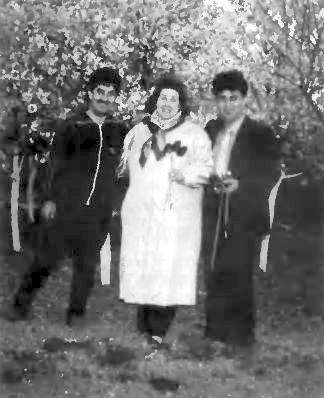
Standing
amid fruit blossoms in Grodno are from left to right, Arturo, Erin,
and Garik.
Following the Conference I stayed on in Moscow where I was able to witness briefly to three very special people. One, Andrei, serves as a leading human rights/Christian activist-interpreter. A special and sincere brother, Andrei is presently in the thick of Moscow democratic ferment and, as a devout Russian Orthodox, open to and interested in working with the Unification Movement.
Meeting my pen-pal Sergey and his wife Dena for the first time was a real thrill for me. They are a humble, unassuming couple who are very curious about Father. They are inspired by our ideal of one family under God and offered to assist our movement in the Soviet Union in any way they can. Both scientists, Sergey and Dena gathered together a small study circle of young professionals who have been examining world religions for the core of universal spiritual truth. The group now wants to put their declaration of faith into practice by purchasing and distributing Bibles and Korans to retired and low-income persons.
Then, a friend drove me 100 miles northwest to the quiet, provincial city of Kalinin on the Volga for an overnight stay with Irena and her family. It was truly refreshing to spend my next two weeks in Soviet homes rather than in a heartless hotel room. Originally named Tver, this regional seat is the home of Kalinin State University where Irena teaches. She took me to meet her mother and we also briefly visited a nursery school that her daughter attends. Then we went shopping downtown and visited the only functioning, but locked, Orthodox Church in town. Irena, her son Aloysha, a friend and I had a delicious lunch at a recently-opened Korean-owned cooperative restaurant. She shared with me the challenges of living a God-centered life in Russia today.
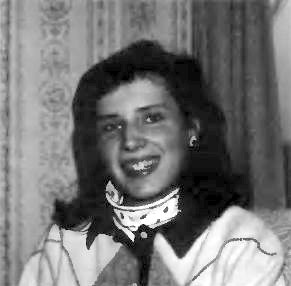
Tanya,
an engineering student in Leningrad.
With a bouquet of tulips, I boarded the afternoon train for the five-hour trip to Leningrad. I was met at the Leningrad station by George, who I had met in November 1988. This past winter George came to America and stayed with me in Washington, DC for two months. George, his girlfriend Olga, and I took a cab to the outlying industrial town of Kolpeno where he shares an apartment with a young couple and their toddler.
Leningrad, the cultural center of the Soviet Union, offers the Hermitage and Russian Museums. I was impressed both with the quality of the art collections and the grandeur of the ornate palaces in which they are located. In the Museum of the Ethnography of the Peoples of the Soviet Union, next door to the Russi.in Museum, I was able to explore the broad diversity of cultures in the present Soviet Union.
Leningrad also hosts a number of long-neglected, large churches, one which, according to George, has been used for years to store skis. During evening vespers, we visited one church which had only been opened for worship for four months and needed considerably more restoration work. But the worshippers, on this weekday afternoon, were there for spiritual life and the unfinished sanctuary did not interfere with their gratitude over having the building returned to them. Over one thousand churches have been placed in the hands of Orthodox believers in the past year; now it is up to devout Christians to raise funds for their restoration.
In Alexander Nevsky Monastery stands the large, baroque Holy Trinity Cathedral. On our first visit, the ornate Italian-style church was closed, but a small kiosk out front was selling New Testaments, devotional books and Easter cards. The funds raised are used to support church work.
Behind the Cathedral was a rundown, vandalized cemetery, on a wooded hillside by a small stream. Sadly, the monuments and tombstones were all cracked or broken, eroded and dirty as well as being overgrown with weeds. This heart-breaking scene, a symbol of 70 years of erosion of goodness and beauty in the Soviet Union, was one that made me want to pray for the deliverance of the nation. I asked George why families had not taken better care of the graves in the first half of the century, and he explained that so many people had died, were arrested or deported to Siberia that there was often no family left to tend to the departed. A small crew of young people had begun washing, repairing and painting the stones and figures of a dozen sites. Out of 250 plots that isn't much, but what a significant beginning! We returned a second day because the cemetery was indeed a spot of serenity and peace in the middle of Leningrad. The Cathedral being open this time, I gave generously to the collection box for restoration work.
This experience helped me to understand the necessity for a demoralized people on the brink of moral and social decay to begin reversing the spiritual erosion through physical reclamation. When the honorable past is revered and loved, then the beauty and inspiration that a result generates personal transformation. As new life begins to stir, a certain basic physical foundation must be rebuilt in order to claim the fullest inheritance from the past.
A new friend, Vera, and I saw a beautiful production at the Pushkin Theater, a classic 18th century love story. The lavish theater, once the best in town with a czar's box, was that night filled with everyday Soviet citizens. The comic play was in Russian but I was able to follow the action. The sets, costumes and lighting were of very fine quality and it was a memorable experience.
My last night in Leningrad I visited Tanya, an engineering student I met last summer. Arriving late in the evening, Tanya and her mother put on a banquet for me and showered me with gifts. I found accurate the saying that, though the stores in the Soviet Union have little food, in the homes, the table is always full. Tanya's mother, a devout believer, prepared the couch for me to sleep and, when I coughed a little in the night, she immediately was full of concern. She appeared at my bedside with a cup of hot tea and herbal medicine, making me feel exceptionally well cared for.
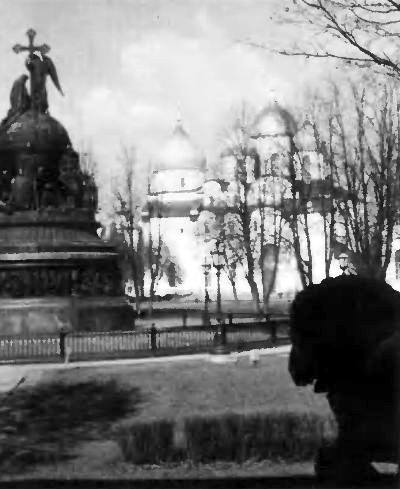
The
Cathedral of St. Sophia and the Millennium Memorial in Novgorod.
On a beautiful Sunday George, Olga and I set out by car for Novgorod, two hours south of Leningrad. The city on the banks of the Volkhov River was chartered in 1019 and served as a pre-Moscow capital of Russia. Later, both Ivan the Terrible and the Germans assaulted this seat of early Russian democracy. Novgorod, historical site of a miracle icon which once saved it from attack, has 77 churches. Today, all but a few have been reconstructed since the war, but only a handful of them are used for worship.
Inside the brick Novgorod Kremlin stands the lovely six-towered stone Cathedral of St. Sofia, now nearly restored. Recordings of Orthodox chants filled the air as we entered. The large iconostasis fills one wall of the narrow sanctuary, while, in the back of the chapel rests a massive carved stone Celtic cross, dating from the 14th century.
The large state museum in the complex has an extensive exhibition of early icons and illuminated manuscripts. Housed in the same building was a contrasting "Museum of the Revolution" with dark, red and black rooms with Soviet and Great Patriotic War memorabilia and artifacts. A great, bell-shaped sculpture in the Kremlin courtyard, cast in 1868, is titled "Memorial of the Millennium." It is boldly and beautifully ringed with key historical figures in Russia's messianic quest. It is topped by two angels and a cross mounted on an orb.
Another treat was a chance to visit the outdoor Museum of Folk Wooden Structures outside the city. This was a totally uncommercial re-creation of the buildings of a typical Northern Russian village, "Vitoslavlits", which had a fresh and unspoiled spirit, unlike any other place I saw. The guide took the four of us into the large two-story home/barn and explained how an inter-generational family lived there, what their daily life was like and what practical objects were used for. Included in the forested, lakeside complex of about a dozen completed buildings, were several wooden churches of various sizes with beautifully crafted onion domes and a feeling of simple faith. The buildings were all unpainted and had a fresh, rustic feel.
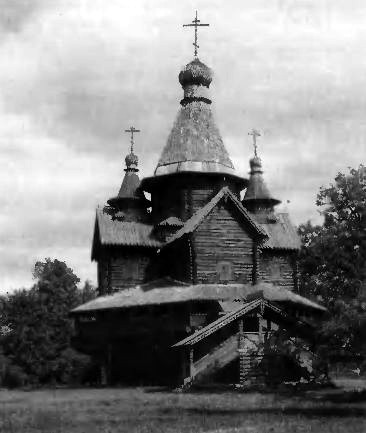
The
Museum of Wooden Folk Architecture in Novgorod.
Tanya and Vera helped me set out by train for Byelorussia. I had a private sleeping compartment and comfortably settled in with my things for the overnight trip southwest.
Arriving in Grodno early on a foggy morning, I was greeted by Andrew, Garik and his brother Arturo. That warm spring afternoon we ventured out to visit some people and see the town. Blossoming fruit trees and colorful pansies made the city of Grodno (300,000) most attractive. Situated on the Polish-Lithuanian border, it has a multi-national Orthodox-Catholic population. In one of the downtown Catholic churches we visited I could see restoration work in progress. The second one we stepped inside was full and the afternoon mass was conducted in Polish. They were both beautifully but humbly decorated.
Because I needed to use a restroom we were admitted to a building that was being used by the local union of artists. The former synagogue was far from a house of worship and had been for many years. A ping pong table was in the rear of the main hall, while lining the room were a number of garish May Day Lenin and Gorbachev billboards. It had been totally neglected and was full of rubble and dust. Garik explained that a group of American Jews had approached the city about possibly restoring this historic site.
Last year my talented friend Andrew was hired by several local countryside congregations to restore the interiors of their churches. I asked to see some he had worked on, so one afternoon Andrew, Garik, Arturo and I drove out into the Byelorussian countryside to a Polish Catholic and a Byelorussian Orthodox church. These two recently painted and decorated village churches are functioning as centers of worship.
And we also went through a Museum of Atheism located in a white, well-kept small monastery which still retained an aura of sanctity. Some of the paintings and icons exhibited were restored but, as my friend Andrew said, "without spirit" by non-believers. Upstairs were displayed artifacts from various periods and traditions. One sign listed church martyrs such as Joan of Arc and John Hus, but I found this a testimony only to the failures of the official church and not of religious faith.
Upon reflection, I feel that even the museums of atheism have served God's purpose over the years by preserving buildings and priceless treasures of
Christianity which otherwise might have been destroyed. I cannot say what the guide was telling the touring schoolchildren, but for me, the museum I saw bears unexpected testimony to the love of God, which shines through.
One special evening Garik, his schoolteacher friend Yuri, and I drove over to a Lithuanian resort park and dined at a rustic little restaurant. The small crowd danced gaily to the band performing folk and lively dance tunes. Yuri expressed a deep desire to come and study further in America and is interested in learning more about Father's work and vision.
I met many other memorable people in Grodno: Garik's joyfully embracing Armenian family; Andrew's wife, children, mother, twin sister, and mother-in-law; Garik's spiritualist friend Lola and a Baptist family; and Andrew's painter friend Sergei. And I had the blessing of renewing and enlarging my friendship with Garik and Andrew on their home turf. Together, these wonderful folks filled my four days in Grodno with adventure, heartistic give-and-take and many opportunities to teach Principle.
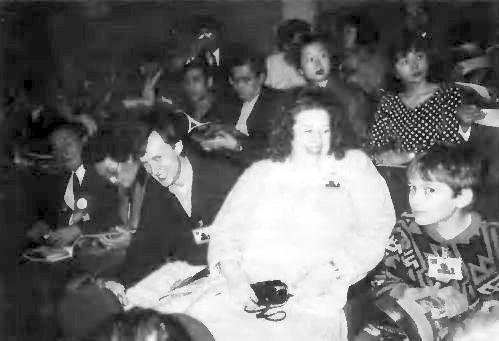
Attending
the Little Angels' Performance during the World Media Conference in
Moscow.
I found that, deprived of much popular entertainment or environmental stimulation, the people of the Soviet Union build close family relations and friendships. For them, wholehearted hospitality and sharing helps relieve the boredom of a somewhat dreary and unrewarding existence. I felt the deep yearning of the people to lead "normal" and fulfilling lives. Open to being loved and appreciated and longing to understand God and the meaning of their existence, I found receptive hearts, affectionate hugs and tears of gratitude wherever I went. The simple hope of a brighter future noticeably raised their spirits and gave them new life. I don't think I have ever meant so much to so many people in my life. Because of the deep connection I was able to make with so many special people during my travels in Russia, I feel called to do pioneer home church work in the Soviet Union as soon as it is possible. The hunger for spiritual nourishment and potential to build a corner of the Kingdom strike me as an opportunity of a lifetime. As we parted in each city, I promised to return to Russia soon. My heart was filled to overflowing as I returned to Moscow via Aeroflot. Garik accompanied me and helped me make my early morning flight out on April 31.
Leaving Byelorussia and Moscow just before May Day, I saw the festive multi-colored flags hung along main thoroughfares by the government, with massive slogans and portraits of leaders displayed to "inspire" the population. I feel that all this communist propaganda is grossly out of touch with the real sentiments of the country. Alongside a cautious, tired mood enveloping the land, is an active search in the most prepared and dynamic people for something and someone to believe in again and a forward direction to take. Those with the most vision and confidence are men and women of faith and courage.
As a postscript to this tale, Garik arrived in the United States for a visit on July 3 and he hopes to study more Divine Principle and the practice of religion in America. Tanya and Andrew will be coming later this year.